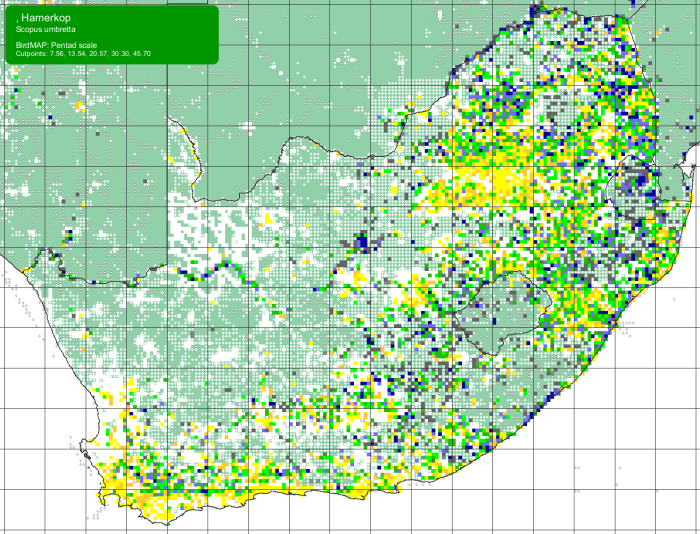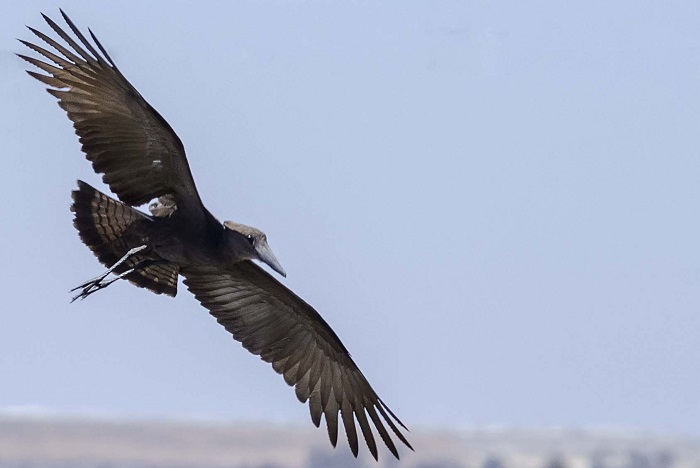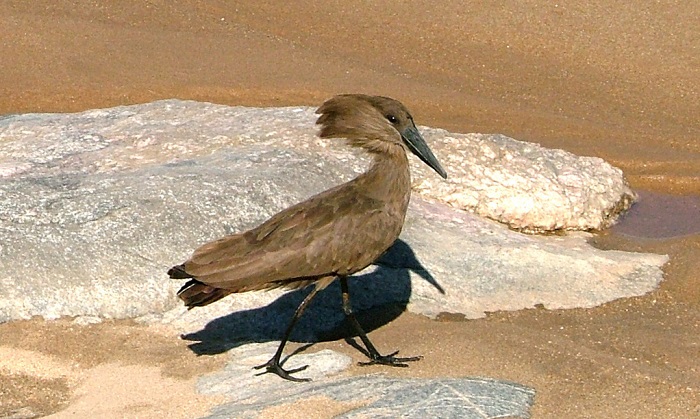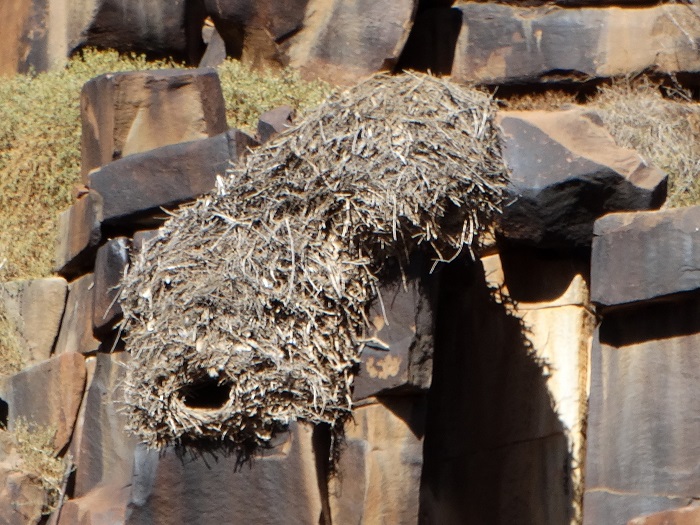Cover image of Hamerkop by Derek Solomon – Mashatu Game Reserve, Botswana – BirdPix No. 9692
The Hamerkop is the only member of the Family SCOPIDAE. They are thought to be most closely related to storks, herons and ibises. The middle toe of each foot has a pectinate (comb-like) claw that is most likely used for grooming the feathers.
Identification
The Hamerkop is a very distinctive and unmistakable species. It is a medium-sized waterbird, similar in stature to a slim domestic chicken.

Okavango Delta, Botswana
Photo by David Kennedy
The sexes are alike in plumage colouration and juvenile birds closely resemble the adults.
The plumage is entirely dull brown and slightly paler on the throat and underparts. The Hamerkop’s most distinctive features are the backward projecting crest and the large, laterally compressed bill with a hooked tip. The legs are black and relatively short. The eyes are dark brown.

Shelly Beach, KwaZulu-Natal
Photo by Lia Steen
The Hamerkop is a unique bird and is not likely to be confused with any other species.

Kruger National Park, Mpumalanga
Photo by David Kennedy
Status and Distribution
The Hamerkop is distributed throughout sub-Saharan Africa and Madagascar. It is also found in south-western Arabia. The Hamerkop occurs throughout southern Africa and is absent only from very arid areas that lack surface water. It is most numerous in the higher rainfall north and east of the sub-continent.

A fairly common resident in southern Africa. The Hamerkop was less widespread historically than it is at present, especially in the arid western regions. Humans have assisted a range expansion into these areas through the development of artificial aquatic habitats like farm dams and irrigation systems.
In some regions the Hamerkop has been negatively impacted by the degradation of wetlands, particularly as a result of cattle trampling. Additionally, the clearing of riparian woodland in places has resulted in the loss of nest sites. It has decreased in numbers in parts of the Western Cape due to its nests regularly being usurped by the Egyptian Goose (Alopochen aegyptiaca). However, on balance, the Hamerkop remains widespread and is currently not of conservation concern.

Klerksdorp district, North West
Photo by Tony Archer
Habitat
The Hamerkop frequents many aquatic habitats, ranging from lakes, pans and dams, to rivers, streams, marshes and swamps. The Hamerkop also inhabits temporary or ephemeral habitats like seasonally flooded ponds and puddles. The Hamerkop is seldom found at estuaries and rarely forages along open coastlines. Due to its relatively short legs, the Hamerkop requires fairly shallow water in which to forage.

Pongola River, KwaZulu-Natal
Photo by Ryan Tippett
Behaviour
The Hamerkop is both diurnal and semi-nocturnal. They are non-territorial and are usually encountered solitarily or in pairs, but sometimes in small groups of 4 or 5 birds. Rarely aggregates in larger groups of up to 50.

Kruger National Park, Mpumalanga
Photo by David Kennedy
They are known to practice mutual allopreening (Two birds preening each other at the same time), and are well known for some interesting behavioural displays. The most characteristic and bizarre of these displays is called False-mounting. This involves 1 bird standing on the back of another while flapping its wings to maintain balance, often while calling incessantly. This may also take place in groups with different birds alternately false-mounting each other, sometimes even with a third bird atop a false-mounting pair. The true purpose of this unusual behaviour is not known.

Between Middelburg and Hanover, Northern Cape
Photo by Tino Herselman
Hamerkops mostly roost in or near the nest, with groups sometimes roosting together in a waterside bush. Single birds may sometimes roost communally with other species like cormorants, egrets and Ibises. Fledglings may roost in or on top of the nest.
They are swift and agile in flight and can take-off with a single upward leap. In flight, the head is partially retracted into the shoulders, but the neck is held fully extended when soaring or gliding. Hamerkops walk with quick, jerky steps, the head and neck moving back and forth with each step.

Moremi Game Reserve, Botswana
Photo by David Kennedy
The Hamerkop is known to use several different foraging techniques that demonstrate its intelligence and versatility. The main foraging method involves either standing and waiting patiently at the water’s edge or walking slowly along the shore, ready to snatch prey from the water or land. They may also use subtle ‘foot-trembling’ while wading in order to lure prey, and can be seen to wait strategically at rapids, grabbing food that drifts or swims past. They can also probe into mud with their bills in search of concealed food. Additionally, the Hamerkop can forage aerially in agile flight, low over the water in order to seize prey from the surface.

Eastern Province, Zambia
Photo by Nico Vromant
The Hamerkop is also observed to hunt from the back of Hippopotamus (Hippopotamus amphibius), and may attend foraging groups of other animals like Banded Mongoose (Mungos mungo) or grazing cattle and Buffalo, using them as beaters to flush grasshoppers. They are also known to scavenge bits of food from around carcasses and will sometimes consume road killed food items.

Kgalagadi Transfrontier Park, Northern Cape
Photo by Eukene Rueda
The specialised bill is laterally compressed and includes a sharp hook at the tip. The bill structure allows the bird to easily manipulate slippery prey so that it can be beaten against the ground or a rock etc. This is done to stun the prey, making it easier to swallow head first. The same action is used to remove the toxic slime from the skin of Platannas (Xenopus spp), the bird periodically rinsing the frog in water between beatings.

Entabeni Private Nature Reserve, Limpopo
Photo by Vaughan Jessnitz
Platannas (Xenopus spp) are the preferred food choice of the Hamerkop. This frog genus has a very similar distribution to the the bird, supporting the theory that Hamerkops are dependent on them as food. They also consume many other frog and toad species, as well as small fish, shrimps and various aquatic and terrestrial invertebrates such as grasshoppers, beetles, termite alates, earthworms and the occasional small mammal.

Chongwe District, Lusaka, Zambia
Photo by Kyle Finn
The Hamerkop breeds throughout the year in southern Africa, with an egg-laying peak during August and September. It is a monogamous, solitary nester.
The untidy nest is a huge, oven-shaped, domed mass of sticks, reeds and other bits of debris. It has a central nest chamber with an entrance tunnel situated low down on the most difficult to access side of the nest. The nest is normally built into the sturdy fork of a tree or on a cliff ledge. Nests may measure up to 2m in diameter and with a roof at least 1m thick. The nest chamber is 30 to 50 cm in diameter and is roughly plastered with mud. The steep entrance tunnel, on the other hand, is smoothly plastered to make it difficult for intruders to access the nest chamber.

Groot Paardekloof, Northern Cape
Photo by Zenobia van Dyk
Nests are constructed equally by both sexes, but may also be built cooperatively by 4 or more birds. Nest construction takes anywhere from 3 weeks to 6 months to complete. The nest begins as a bowl-shape before the sides and roof are added. The wicker-like nest walls and roof are made of carefully interwoven sticks with the pair working together to weave the sticks in place. Completed nests are structurally sound and the roof can withstand the weight of a full-grown person! The central nest chamber is then covered with sticks and other nesting material. The male then brings mud to the female who uses it to line the walls and floor of the chamber, as well as the entrance tunnel.
The completed nest can weigh up to 50kg. The true purpose of such a disproportionately large nest is not fully understood. It has been suggested that the nest provides security and a warm microclimate, enabling Hamerkops to lay larger clutches than other related birds, and to leave nestlings for longer periods while adults forage.

Tulbagh district, Western Cape
Photo by Mark Stanton
If left undisturbed, Hamerkops may use the same nest for up to 4 years. Nests are sometimes usurped by other birds, most notably by Egyptian Goose (Alopochen aegyptiaca) and Western Barn Owl (Tyto alba), also by bees, mammals and reptiles.
Anywhere from 1 to 7 plain white eggs are laid per clutch. The incubation period lasts for around 30 days and and incubation duties are shared by both sexes. The nestling period then takes a further 45 to 50 days and the young are fed and cared for by both parents. At around 55 days old the fledglings are quite agile and are able leave and return to the nest.

Kruger National Park, Limpopo
Photo by Colin Summersgill
The Hamerkop is a long-lived species with a life expectancy of more than 20 years.
Further Resources
This species text is adapted from the first Southern African Bird Atlas Project (SABAP1), 1997.
The use of photographs by Colin Summersgill, David Kennedy, Derek Solomon, Eukene Rueda, Kyle Finn, Lia Steen, Mark Stanton, Nico Vromant, Salim Lee, Tino Herselman, Tony Archer, Vaughan Jessnitz and Zenobia van Dyk is acknowledged.
Virtual Museum (BirdPix > Search VM > By Scientific or Common Name).
Other common names: Hamerkop (Afrikaans); uThekwane (Zulu); Uqhimgqoshe, Uthekwane (Xhosa); Mmamasiloanokê (Tswana); Hamerkop (Dutch); Ombrette d’Afrique, Ombrette africaine (French); Hammerkopf (German); Pássaro-martelo (Portuguese).
Recommended citation format: Tippett RM 2024. Hamerkop Scopus umbretta Biodiversity and Development Institute. Available Online at https://thebdi.org/2024/06/19/hamerkop-scopus-umbretta/
A list of bird species in this format is available here.

Kasisi, Lusaka Province, Zambia
Photo by Salim Lee

